Order Castles of the Third Reich
| Order Castles of the Third Reich | |
|---|---|
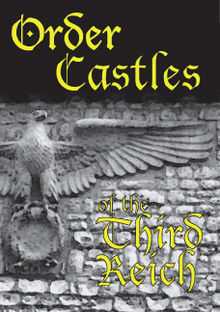 | |
| Directed by | R.J. Adams |
| Produced by | Diane C. Adams |
| Written by | R.J. Adams |
| Distributed by | History Quest Video |
Release dates |
|
Running time | 60 min. |
| Country | U.S.A. |
| Language | English language |
A documentary motion picture, Order Castles of the Third Reich tells the history and purpose of the three NSDAP Order Castles, Ordensburg Krössinsee, Ordensburg Vogelsang, and Ordensburg Sonthofen (a never-built fourth school was planned within the castle walls of Ordensburg Marienburg, once the seat of the Teutonic Knights). Written and directed by R.J. Adams, the film captures all four castles as they appeared under the Third Reich and as they appear today.
Synopsis
A documentary film tour of Odensburgen Krössinsee, Vogelsang, Sonthofen, and Marienburg by using current HD footage of each site interspersed with first generation archival footage and never before seen photos. Also featured is Heinrich Himmler's castle at Wewelsburg, the finance school at Herrsching and a complete tour of the SS-Junkerschule Bad Tölz (SS officer's training center).
The NS-Ordensburg program began in the spring of 1933 when Adolf Hitler and Robert Ley, Reichs organization leader visited a trade school in Bernau where both men became convinced that similar academies were needed to educate the Führer's rising generation, more specifically Hitler's political soldiers. The schools were planned in various remote locations such the Pomerania lakes District in West Prussia, the Eifel in west Germany, the Allgäu in Bavaria and along the Nogat River in East Prussia.
Requirements Ordensjunkers (Castle Squires) candidates were required to be at least 5 ft 4, between 23 and 26, racially pure and in good health and without any physical limitations. At the outbreak of the war a very high percentage of Junkers were killed in action.
Krössinsee
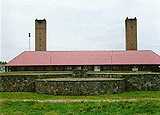
Completed in less two years and dedicated simultaneously with Vogelsang and Sonthofen on April 24, 1936 by Adolf Hitler, Krössinsee represented the program's first year of training and ending four years later at Marienburg. Built by architect Clemens Klotz, the Volkish styled complex of buildings consisted of numerous buildings with granite foundations, rustic stone facades and thatched roofs and cost an estimated 20 million Reichsmarks to complete. The complex was laid out on a grid system and consisted of two 150-foot (46 m) towers, the barracks called the Kameradschafthausen, a court of honor, sports hall and mammoth administration building.
Adolf Hitler Schule In 1937, the students known as Ordens Junkers began sharing the compound with older boys of the Hitlerjugend, the Hitler Youth. These boys between 12–18 years eventually became the sole occupants of all three Castles with the Nazi invasion of Poland (1939) and the start of World War II.
Classes began each morning at 7 am and included studies in philosophy, politics and world history. Afternoons were devoted to military drills, battle tactics, sports and equestrian techniques. The school was recognized for its outstanding equestrian program. The nearby lake provided the means for students to develop their rowing and sailing skills. The commanding officer of the castle was Otto Gohdes.
On May 16, 1941, the Ordensburg was renamed Die Falkenburg am Krössinsee Castle Falkenburg at lake Krössin by the Robert Ley, the Reichs Organization leader and Minister of Labor.
Today, the complex is used as a military installation by the Polish Army's 2nd Battalion, 12th Panzer Brigade.
Vogelsang
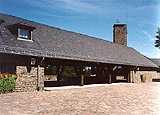
The second year of study in the Junker program was held at Burg Vogelsang locating on a slope overlooking the Urft river in the region of west Germany called the Eifel. Built by Clemens Klotz, the sprawling complex included the Adlerhof (Eagle court), a church like structure called the Gemeinschaftshaus (community house), Wirtschauftgegebäude (economics building), Haus des Wissens or (House of Knowledge), the Kameradschaftshäusen or (Barracks), the Burgsschenke or cantine, Swim and sports Hall. A massive building called the Kraft durch Freude ("Strength through Joy") Hotel with 2000 beds was planned but never built due to the outbreak World War II.
The daily routine consisted of 6:00 early morning exercise 7:00 muster, 8:00 - 10:00 project groups, 10:00 - 12:00, mess followed by lectures and afternoon sports, group projects 5:00 - 6:30 pm and rest at 10:00 pm. Studies consisted of National socialist race science, geopolitics and intensive sportive education (especially equitation). Another emphasis was pilot training,
With the outbreak of war in September 1939, the Junkers were called to arms and the Castle was handed over to Wehrmacht (German Army) and used for accommodating troops during the western campaign of 1940 and again in December 1944 during the Battle of the Bulge. In the interim Vogelsang was transformed into an Adolf Hitler Schools, where members of the Hitlerjugend between 15-17 were given the same basic studies as the Junkers as well as extensive training in military tactics.
Destruction came in the winter of 1944 an allied bombing raid destroyed the east wing and a portion of the south wing of the Adlerhof . In February, 1945 the site was occupied by the 47th U.S. Infantry division followed by the British army six months later and finally by the Belgian army. Renovated by Belgian military authorities, the compound became a training center for NATO forces from all over the world until its closure in 2006.
Today the former Ordensburg is open to the general public and the surrounding area is used for hiking the trails of the Eifel National Park.
Sonthofen
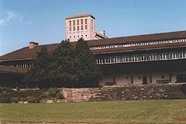
It was at Ordensburg Sonthofen that the Junkers would have begun their third year of study but in September 1939 when the war broke out the leadership course came to an abrupt end without anyone ever graduating from the elite program. However, the vast complex was to serve as an important facility when three hundred members of the Hitlerjugend (Hitler Youth) were transferred from Ordensburg Krössinsee to Sonthofen in 1937.
Construction began in the fall of 1934 but as with Krössinsee and Vogelsang, the project was never fully completed. Designed by one of Hitler's favorite architects, Hermann Giesler, the huge complex underwent revisions and expansions lasting eight years at a cost of 150 million German Reichsmarks.
Phase one which took two years to build was dedicated simultaneously with Krössinsee and Vogelsang on April 24, 1936 and included the Burg (central castle) with its Ehrenhof (court of honor), Wohnhof (assembly grounds) and the east and west wings of the structure consisting of the Fuchsbau (Wolf's Den/cantine) and Gemeinschaftsraum (community room).
Phase two completed in 1937 included the Unterkunftsgebäude (accommodations or barracks building), Turnhalle (gymnasium) and the 140-foot (43 m) Palace (tower) which was completely functional.
Phase three consisted of the Schwimmhalle (pool), Musiksaal (music room), Gymnastiksaal, Technisches Haus, Seminarbau as well as several other structures.
Daily HJ schule schedule began with inspection at 6 am followed by a rigid class room study of German history, geography, Social studies, World history, studies in racial doctrine, fine arts and metal works. Sports and conditioning, a vital part of the program was conducted in the late afternoon. Skiing played an essential role during the long winter months. From 1936 to 1941, Burg Sonthofen was under the command of Reichstag deputy Robert Bauer.
Following the war in April 1945, was occupied by the French military as a hospital followed a few months later by the American Army who established a training center for US Constabulary troops. In 1956 the facility was handed over to the Bundeswehr and was renamed the General Ludwig Beck Kaserne one of the principal players in the plot to assassinate Adolf Hitler known as "Operation Valkyrie"
Marienburg
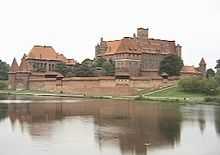
Nestled on the banks of Poland's Nogat river is one of the greatest castles of the middle ages. Built during the 13th and 14th century by the legendary Teutonic Knights, Marienburg not only served as the order's principal fortress but during the Third Reich it was used as a Nazi shrine for mythical Germanic worship. Youth groups from all over Germany would descend on the castles to partake in a variety of ceremonies, rituals and theatrical pageants. The leadership of the Reich found the strict military and monastic life style of the Teutonic order very conducive to the development and training the Führer's rising generation.
Had the NSDAP leadership program continued beyond the second year of training at Vogelsang the Ordensjunkers would've advanced from their third year at Sonthofen to their fourth and final year at Ordensburg Marienburg. Within the shadows of the historic Teutonic fortress where the legendary knights ruled the Prussian lands five centuries before, the Junkers of the Third Reich would've completed their training just outside the wall of the lower castle.
See also
Literature
- Rolf Sawinski: Die Ordensburg Krössinsee in Pommern (Gebundene Ausgabe), Aachen 2004, ISBN 3-933608-77-5
- Hans-Dieter Arntz: Vogelsang - Geschichte der ehemaligen Ordensburg, Helios-Verlag, Aachen 2008, ISBN 978-3-938208-71-7
- Hans-Dieter Arntz: Ordensburg Vogelsang... im Wandel der Zeiten. Helios-Verlag, Aachen 2007, 64 S., ISBN 978-3-938208-51-9
- Hans-Dieter Arntz: Ordensburg Vogelsang 1934–1945, Beitrag zum Deutschland Archiv – Drittes Reich (Dokumente), Archiv Verlag Braunschweig 2009.
- Hans-Dieter Arntz: Ordensburg Vogelsang 1934 bis 1945 – Erziehung zur politischen Führung im Dritten Reich. Helios Verlag, Aachen 2010, 6. Auflage ISBN 978-3-86933-018-1
- Ruth Schmitz-Ehmke: Die Ordensburg Vogelsang: Architektur – Bauplastik – Ausstattung. (Landschaftsverband Rheinland - Landeskonservator Rheinland. Arbeitsheft 41) Rheinland-Verlag, Köln. 2003. (2. veränd. und erw. Auflage)
References
- Hatheway, Jay (2004). In Perfect Formation: SS Ideology and the SS-Junkerschule-tolz. Schiffer Military History. ISBN 0-7643-0753-3.
- Gerhard Klein: Die NS-Ordensburg Sonthofen 1934 bis 1945. In: Paul Ciupke u. Franz-Josef Jelich (Hrsg.): Weltanschauliche Erziehung in Ordensburgen des Nationalsozialismus. Zur Geschichte und Zukunft der Ordensburg Vogelsang Geschichte und Erwachsenenbildung, Bd. 20. Essen 2006. S. 65 - 84
- Johannes Voigt: Geschichte Marienburgs, der Stadt und des Haupthauses des deutschen Ritter-Ordens in Preußen. Königsberg 1824, 588 Seiten (Druckfehler-Berichtigung auf S. 589-590), online.
External links
- Official website
- Order Castles of the Third Reich at the Internet Movie Database
- (English), (German)
- Military forum
- (English), (German) The Ordensburg in Sonthofen, Allgäu
- (English) Wewelsburg from 1933 to 1945, place of cult and terror
- (German) Historical photos of the Wewelsburg
- (English), (German)
- (English), (German) The Ordensburg in Sonthofen, Allgäu
- (English) Wewelsburg from 1933 to 1945, place of cult and terror
- (German) Historical photos of the Wewelsburg